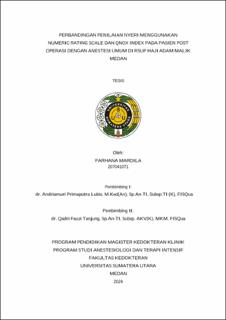Perbandingan Penilaian Nyeri Menggunakan Numeric Rating Scale dan Qnox Index pada Pasien Post Operasi dengan Anestesi Umum di RSUP Haji Adam Malik Medan
Comparison of Pain Assessment Using The Numeric Rating Scale and Qnox Index in Postoperative Patients Undergoing General Anesthesia at H. Adam Malik General Hospital Medan

Date
2024Author
Mardila, Farhana
Advisor(s)
Lubis, Andriamuri Primaputra
Tanjung, Qadri F
Metadata
Show full item recordAbstract
Introduction: Postoperative pain is experienced by many patients undergoing surgery. Pain evaluation using the Numeric Rating Scale (NRS) is routinely used, but the results may lack objectivity. The use of the qNOX index is expected to provide an alternative for non-invasive pain assessment in postoperative patients.
Methods: This study employed a cross-sectional analytical method to compare the effectiveness of postoperative pain assessment in the recovery room for patients undergoing surgery with general anesthesia, using both NRS and the qNOX index. Sample size was calculated using G*Power software. Postoperative pain was assessed at 15 minutes and 60 minutes using the NRS and the qNOX index. Data analysis utilized paired T-tests and Wilcoxon tests.
Results: A total of 38 patients were included in the study. The majority were female (57.9%) with a mean age ± SD of 43.03 ± 13.56 years. About 68.4% of the sample experienced moderate pain. The qNOX index and NRS scores were lower at 60 minutes postoperative compared to 15 minutes (89 [66–99] and 7 [0–8] vs. 82 [50–99] and 5 [0–9]). The study found significant differences between NRS and qNOX scores at 15 and 60 minutes in detecting postoperative pain (NRS 6.26 ± 1.54 vs. 4.79 ± 1.58, p < 0.001) (qNOX 87.08 ± 8.67 vs. 82.29 ± 11.23, p < 0.001). NRS was more sensitive in detecting pain changes over time compared to the qNOX index (r -0.68 vs. -0.77).
Conclusion: NRS is more effective in assessing postoperative pain compared to the qNOX index.
